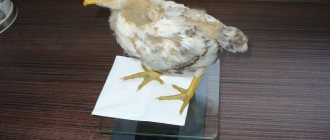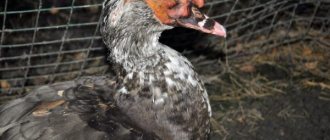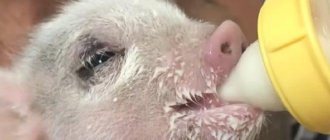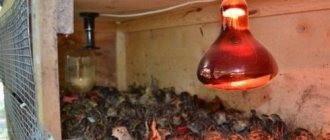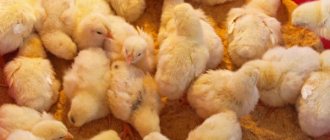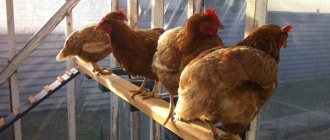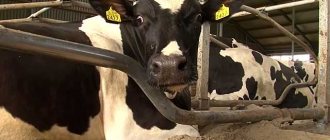Chicks that are born naturally are initially under the constant care of their mother hen. If the yellow-throated babies hatched in an incubator, then caring for and monitoring them is already your responsibility.
Therefore, in order to avoid various troubles associated with the health of growing pets, you need to follow the rules of feeding them, maintain the required temperature conditions and provide your “squeaky pupils” with the appropriate conditions for good growth.
This method of breeding chickens is in quite high demand, as it has a number of significant advantages , among which are the following:
- Advantageous application: during one season, at least ten broods can be made in the incubator.
- Easy to use: the device does not require additional investments or special skills in handling it, and you also do not need to worry about eggs that the hen could peck.
- More than fifty eggs can be laid at a time.
- Year-round hatching of chicken offspring: built-in additional sensors and devices expand the functionality of the incubator, thereby ensuring hatching of chicks in summer and winter.
What you need to know about raising chickens at home
Breeding young animals is one of the most important stages of running a successful poultry farm. If the chicks are hatched under a hen, no additional heating is required, since the chicken itself will provide the necessary temperature conditions and protection.
If a poultry farm plans to raise chickens from an incubator, a heated and fenced place must be prepared in advance for them.
Care
For young chickens, correct temperature conditions are extremely important. If it is kept within normal limits, the chicks are mobile, eat well and develop normally. If the temperature is too low, they begin to crowd and press closer to the heat source, quickly weaken and eat poorly. If the temperature is too high, the chicks will move away from the heat source, drink frequently, eat poorly, and spend a lot of time lying around.
A simple way to maintain temperature is to use a regular flask or heating pad, which is wrapped in thick cloth. The water must be changed periodically.
Lighting also plays an important role. In the first ten days of life, chicks should be exposed to light around the clock. In the future, the duration of daylight hours is gradually reduced and increased to 9-10 hours.
Content
In some farms, hatchery chickens are kept in special boxes that are covered with cloth and not heated. This is a gross mistake, since the chicks do not have enough warmth and air, and they very often die or are delayed in development.
Planting onions before winter - planting dates and how to do it correctly
Figure 1. Drawing and photo of a brooder
It is better to use special boxes or boxes, and install light bulbs or reflectors for heating (Figure 1). To prevent the chickens from running away from the heat source in the first few days, it needs to be covered with a cardboard screen. In the first five days, the temperature in the poultry house should be kept at 30 degrees. Subsequently, it is reduced: on the 10th day to 26 degrees, and then three degrees weekly until the temperature reaches 16-18 degrees.
Walking in the fresh air has a good effect on raising healthy and viable young animals. They can be carried out in warm, calm weather, since the sun's rays saturate the body with vitamin D. However, in damp and rainy weather, chickens can be walked only from two months of age.
Tips for Beginners
There are several practical tips that will help novice poultry farmers raise young birds correctly. First of all, it should be taken into account that it is better to raise chickens under a brood hen, since only she can provide the optimal temperature regime for the chicks.
In addition, it is important to consider a balanced diet. Some farms practice feeding exclusively with compound feed. However, this only makes sense if the birds are raised in large quantities for sale. For home breeding, it is better to prepare food yourself, using fine-grained cereals, dairy products, fresh herbs and vegetables.
Requirements for conditions of detention
Day old chicks
Usually, at home, a poultry farmer does not have a special brooder for chickens, in which optimal conditions of temperature, humidity and lighting are automatically maintained.
Therefore, you need to create them yourself, and constantly monitor this process in order to notice unwanted changes in time.
The first few days after the incubator, chickens can be kept in boxes or cardboard boxes. The room in which they are installed must be protected from precipitation, have ventilation and electrification. Daily temperature fluctuations in it are undesirable.
The bottom of the box should be covered with a sheet or other fabric that will not slip. It is strictly not recommended to use newspapers as bedding. The chickens' weak legs will move apart, and many of them will get twines that will have to be straightened later.
After a week, you can move them into a cage with a dense mesh bottom, which will make cleaning easier.
Small chickens are the most demanding regarding the following maintenance parameters:
- temperature;
- lighting.
They are easy to provide using both specialized equipment and ordinary electrical household appliances. Let's take a closer look at these parameters and how to maintain them.
Temperature
Newly hatched chickens are characterized by the absence of subcutaneous fat and the presence of only a weak fluff, which is not able to fully provide them with warmth. Therefore, for the first 5 days they should be kept at a constantly high temperature of 29-30 degrees. It usually doesn’t get this hot around the clock, even in summer, so you’ll have to use additional heat sources.
To do this, the box with chicks can be moved to a radiator or convector if the birth occurred in winter. During the warmer months, you can use other sources, such as portable electric heaters, special infrared lamps, or regular incandescent light bulbs.
It must be taken into account that the need to maintain temperature will be acute for a long time, so energy costs will be significant. It is better to select a heat source whose maintenance will be cheaper.
You need to plan in advance how to raise chickens and how much cost it will incur. This will enable you to calculate the optimal number of livestock to cover the cost of their initial maintenance and feeding.
Infrared lamps have high efficiency, so they are specially produced for heating animals. If you install a lamp, no matter what type, it can be connected through a thermostat, such as is used in an incubator.
When it is not there, the lamp is installed above the box where the chickens are kept, at a distance of 30-40 cm. A thermometer is placed on the floor for several minutes and the temperature is measured. If it is too high, then the lamp should be raised higher, and if it is low, then, on the contrary, brought closer.
You should not worry that the required temperature is only under the lamp, and it is cool in the corners of the box, since the chicks will rest in the warmest place and will not feel discomfort. If there are too many of them and they all won’t fit, then you should add the number of lamps.
From the sixth day, you can gradually lower the temperature by one degree every few days. By the age of one month, the birds will be fully adapted to being kept at + 18-20, which will eliminate the need for additional heating.
Lighting
Correct lighting
For the first seven days of life, it is important for chicks from the incubator to be in constant light. Starting from the second week and until the end of the third, the duration of daylight hours should be gradually increased to 9 hours.
And only with the approach of maturity, starting from the fourth month, the duration is gradually increased and brought to the norm of adults.
If there is no timer available that would automatically control the duration of lighting, then this will have to be done manually. It is very inconvenient to wake up at night to turn off the lamp for several hours and then turn it on again.
Therefore, many poultry farmers are starting to make night mode for small chickens during the daytime. At first, the break in lighting is very short, so it is really easier to carry it out when the owner is awake.
Gradually, you can shift the shutdown schedule and adjust it to natural conditions.
Caring for chickens in the first days of life
The future development and health of chicks depends on many factors. But even after creating all the conditions for growth for the bird, it is difficult to expect good results if the chicks are initially weak. Therefore, when selecting from the incubator, young animals are strictly sorted, taking only the most viable individuals for further cultivation.
The first days of life are the most difficult and responsible period for both chicks and the poultry farmer.
Caring for day-old chicks, which are the most vulnerable to disease and often suffer from an incorrectly selected diet, should be aimed at creating and maintaining:
- required temperature conditions;
- optimal air humidity;
- lighting and ventilation modes;
- balanced diet and nutritional dosage.
Dried, strong chicks are transferred from the incubator to a brooder with conditions created for a comfortable environment for the chicks or placed under an experienced hen.
The basic requirements for the premises where the chicken population is located are:
- dryness and cleanliness;
- maintaining proper temperature and humidity;
- properly selected lighting and ventilation modes.
Before the poultry house receives chickens, it is cleaned, disinfected, dry, loose bedding is laid, the presence of rodent protection is checked, and it is equipped with everything necessary to support the life of the pets.
Such equipment includes not only lamps and heating devices, hygrometers and thermometers, but also feeders and drinking bowls. Their design must be chosen in such a way that they are safe to use, and the quantity is determined based on the number of livestock. When keeping chickens at home, no more than 12 chickens are housed per meter of area.
Subsequently, the premises are regularly washed, old bedding is removed, disinfection and ventilation are carried out.
Caring for day old chicks
After the chicks are born, they must be left in the incubator until the fluff dries. Chickens from the incubator are transplanted into boxes or boxes prepared in a timely manner. You can put soft cloth, paper or sand on the bottom as bedding; all this will suit the hatched chickens.
Hatched chicks need optimal temperature conditions. How many degrees there should be will be described in more detail in the following table.
How comfortable the temperature regime can be tracked by the behavioral characteristics of young animals. If there is a lack of heat, they will begin to cluster in groups under the lighting fixtures. If a stampede occurs, there can be death.
The room for chickens should be equipped with heaters, and heat lamps or incandescent lamps should be installed above the box where the chicks sit directly.
The place where young animals are kept must be kept clean and dry. The litter needs to be replaced regularly
The owner is advised to pay due attention to the cleanliness of the down and feet of the chickens. A dirty and wet chick can very quickly catch a cold, at best
Good growth and development is influenced not only by the food supply, but also by how high-quality, fresh and clean the ingredients themselves are. The feeding area must meet sanitary and hygienic requirements. It is recommended to choose a feed container that the entire chicken cannot fit into. There is one more requirement for open feeders - before distributing food, the previous one must be removed from there without any residue.
Chickens in a cage
According to statistics, deaths can occur from low-quality food products, which will lead to economic damage for the farm. It is recommended to diversify the feed base as much as possible, and, of course, ensure that the components are of the proper quality.
A good breeder constantly monitors the health of the entire livestock. If a weakened individual is identified, it must be removed, the cause identified and raised individually, using vitamin complexes in consultation with a veterinarian.
Chickens can be released for walks from the age of 7 days. Sun rays are necessary for young livestock; they are preventative against rickets and other ailments that can be caused by a lack of vitamin complexes.
Preparing to keep chickens
In boxes
In the first days of life, chickens live in warm and dry boxes made of wood or cardboard, which must be disinfected and non-slip material placed on the bottom. The humidity of the environment is maintained within 60-70%.
How to make a potato digger for a walk-behind tractor with your own hands?
On bedding
The maintenance of future chickens is seriously affected by permanent deep litter, which releases a lot of thermal energy. Such warm material protects the paws of young animals from cold temperatures, having a positive effect on the health of pets. With constant decomposition occurring in the material through the action of bacteria, young chickens have biologically active substances as an auxiliary source. For bedding it is better to use:
- Sawdust;
- Straw chaff;
- Peat;
- Wood shavings.
In cells
- They should be clean and dry.
- Supported:
- Correct ventilation and lighting;
- Required humidity and temperature conditions.
Conditions for keeping laying chickens
Chickens of egg-laying breeds are quite demanding in terms of living conditions. Therefore, it is necessary to organize a comfortable home for them, in which they will feel confident and calm.
Temperature and humidity
Laying hens tolerate low temperatures well. However, under such conditions their egg production decreases. Therefore, the temperature in the chicken coop must be maintained at least 15°C. There are more stringent requirements for keeping chickens. In the first 2 weeks, babies need to maintain a temperature of 28-30°C. In the future, the indicators can be reduced to 20-22°C.
To select the optimal temperature regime for raising laying hens, it is necessary to observe the behavior of the chickens. If the chicks are pressed against each other, then they are cold - the temperature needs to be increased. If the kids are sitting separately and look lethargic and sleepy, the temperature should be lowered a little.
Laying hens do not tolerate high humidity well; birds develop inflammation of the eyes and respiratory tract. In addition, parasites and pathogenic microorganisms thrive in such conditions. For the normal well-being of young animals, you will need to take care of the ventilation system. You can do this in several ways:
- organize several small windows;
- make several through holes on opposite sides of the room: on one wall at the top, on the other at the bottom;
- equip exhaust pipes, any material will do.
Week-old laying chicks are kept at 75% humidity. By 2 weeks the rate will need to be reduced to 65%.
Too dry air can also cause discomfort for poultry house inhabitants. Therefore, you will have to regulate the humidity inside the room using vent plugs.
Lighting in the poultry house
Chickens of egg breeds love light. In darkened rooms their performance is noticeably reduced. The optimal length of daylight hours for good egg production is from 6.00 am. until 19.00 In the cold season, such conditions will need to be maintained using artificial lighting sources.
Experienced poultry farmers advise organizing both natural and artificial lighting inside the poultry house. In the first case, you will need to make several windows in the chicken coop. One thing is allowed - but a big one. In this case, it is worth protecting the equipped nests from direct sunlight.
For artificial lighting, it is recommended to use incandescent lamps. To maintain optimal conditions for laying chickens, it is necessary to organize the light regime as follows:
- During the first 7 days, do not turn off the lights at all;
- in week 2 you need to turn off the lighting for 2 hours a day;
- at week 3 - for 4 hours;
- at 1 month - for 6 hours;
- at 2 months - for 8 hours;
- at 3 months - for 10 hours.
Until the chicken reaches reproductive age, it is necessary to maintain the duration of daylight hours within 14-15 hours. This will help avoid early puberty. Hens that lay eggs too early lay small eggs and have poor egg production throughout their lives.
To avoid fire and death of birds, it is recommended to place incandescent lamps in shades.
What to feed chickens
To ensure that the young do not have health problems or developmental delays, the correct diet must be followed immediately after hatching. In the future, the variety of food is gradually expanded, accustoming individuals to adult food.
It is important not only to choose the right products, but also to follow a specific feeding schedule. At first, food is given out every two hours, gradually increasing the interval between meals. At one month of age, the number of feedings should reach three times a day.
First of all, the diet depends on the age of the chicks, so we will consider in more detail what food to give at different periods of development of the young.
DIY food
Properly selected and prepared feed is the key to successful rearing of young animals. In order for the chicks to fully develop, you need to use only fresh and natural products, and it is better to give them out at the same time.
The following products are considered the best food for chicks:
- Cottage cheese mixed with fine corn grits in equal proportions;
- Ground oatmeal, wheat or barley;
- Low-fat kefir or yogurt serve as a valuable source of protein and calcium, so they are included in the diet within a few days after the chicks hatch;
- Greens (young nettle, plantain, dandelions, clover or green onions) in crushed form serve as a valuable source of vitamins and beneficial microelements;
- From the 10th day of life, boiled and fresh chopped vegetables are introduced into the diet;
- Mineral supplements and small pebbles are also an important part of feeding. They not only stimulate the process of food digestion, but also serve as an important source of microelements.
There should be separate feeders for dry and wet food, and when preparing wet mash it is important to strictly follow the proportions. You need to prepare only enough food to eat at one time. If the mash remains in the feeder, the chicks may contaminate it, or the product itself will turn sour and cause poisoning.
Poultry farms often practice feeding special feed for chickens. It is not at all necessary to buy it, since you can prepare a similar product yourself (Figure 2).
To prepare, you need to mix the following components (as a percentage of the total mass):
- Corn (50%);
- Wheat (16%);
- Cake (14%);
- Low-fat kefir (12%);
- Barley (8%).
Figure 2. Main components of compound feed
All grains are thoroughly crushed and mixed with kefir. This feed is used for the smallest chicks that have recently hatched. For older individuals, the list of components is expanded, supplementing it with fish meal, feed yeast, unrefined sunflower oil and fresh chopped herbs.
Chicken feeding diet
You cannot feed chickens on a cold floor, otherwise they will catch a cold. In no case should chickens climb into feeders and drinkers with their feet: feed and water contaminated with droppings cause intestinal diseases, and wet litter is detrimental to immature chickens.
For the first 10 days, chickens are fed every 2 hours. During this period, the best food for them will be finely chopped hard-boiled eggs, crumbly cottage cheese mixed with semolina or corn grits. For 10 chickens, give one egg or 50 g of cottage cheese mixed with 50 g of cereal.
Feeding chickens.
It is useful to give chickens small cereals, lightly ground rolled oats, chicken feed, adding dry milk (1/4 of the volume of cereal or mixture of cereals) and one ground multivitamin tablet (for 10 chickens). This dry mixture is convenient because the poultry farmer can go away for a long time, pouring feed into the feeder, and the chickens themselves regulate their feed consumption. After each feeding, check that all chicks have full crops.
From 3-5 days of age, chickens are taught to eat finely chopped greens; at 5-7 days of age, it is good to give crumbly mash with yogurt, meat and fish broths, as well as meat and fish waste (5-7 g per head), from 10 On the day they give boiled potatoes, grated carrots, pumpkin, zucchini and other vegetables.
Wet crumbly mash should be eaten within 30-40 minutes (they give 30-40 g per head), the remains must be removed (soured feed causes poisoning and death of chickens).
Fresh yogurt, kefir, and whey are very useful for the intestines of chickens, which are given in the morning, and then the drinking bowls are filled with fresh water. As a disinfectant, a weak solution of potassium permanganate is given 2 times a week for half an hour, but it should not be given immediately unless necessary in the first days of the chickens’ life.
Starting from 10 days of age, chickens are given finely crushed chalk, well-boiled ground eggshells, and separate feeders should always contain fine gravel or coarse sand.
How to buy healthy chickens?
The age of chickens offered for sale ranges from 1-10 days.
Raising chickens at home is a profitable business
The older the chicks, the higher their value and the less likely they are to die. The normal figure is considered to be 46-48 surviving individuals out of 50.
You can buy chickens at a poultry farm, from private owners or in specialized hatcheries. When purchasing, you should study the appearance and behavior of the chicks.
Rules for choosing day-old chicks
Healthy day-old chicks are mobile and completely dry chicks that have:
- pure fluffy fluff;
- overgrown area of the umbilical cord (without any discharge);
- clean pink cloaca;
- adequate response to noise;
- harmonious body composition;
- smooth, thick, well-pigmented beak.
Rules for choosing week old chicks
Chicks at the age of a week are active chicks with:
- fluffy, clean plumage;
- soft belly;
- harmonious body composition;
- straight, pigmented beak;
- adequate response to noise;
- the ability to peck;
- wings pressed to the body;
- uncontaminated pink cloaca.
Rules for choosing month-old chicks
You can buy chickens at the poultry farm.
Month-old chickens are active chicks that have:
- adequate response to noise;
- smooth feathers (no dirt or droppings);
- relaxed abdomen;
- harmonious body composition;
- smooth, well-pigmented beak;
- well-defined pecking skill;
- uncontaminated pink cloaca;
- wings tightly pressed to the body.
Proper feeding of chickens
Proper feeding and care of chickens in the first days of life guarantees the production of healthy young within a few weeks after hatching.
Feeding broilers: video, the basis for maximum fattening productivity (read more)
Feeding chickens: norms, diet, caring for chickens in the first days.
Tips for raising chickens on a backyard farm are based on many years of observations and experience of successful poultry farmers. It is enough to follow certain rules and traditions of keeping poultry and your chickens will be healthy and strong, and mortality will be minimal.
Previously, many poultry farmers believed that chickens should be fed only on the second day of their life. It was a mistake. Poultry scientists say something else: the earlier you start feeding chickens, the faster their residual yolk is absorbed and they develop better.
Good feeds for chickens in the first days of their life are; finely crushed high-quality grain mixture, finely chopped hard-boiled egg, well-squeezed non-acidic cottage cheese, hard-boiled porridge, sour milk.
From the very first days of growing, chickens should also be given finely chopped fresh greens - alfalfa, clover, nettle. Flour mixtures from grain, animal and mineral feeds are gradually introduced into the diet: first dry mixtures, and then wet ones. To moisten the mixtures, use whey with pressed yeast diluted in it.
Chickens up to one and a half to two months of age are given dry mixture as much as possible: the feeder with the dry mixture should be kept near the chickens at all times.
Until ten days of age, chickens are fed six times a day, from the tenth day to one and a half months of age - five times, and then switch to four feedings a day. Feeders for wet mash should be washed and dried frequently, and when feeding chickens this is especially important: sour and contaminated feed causes disease.
The number of feeders and drinkers must be sufficient, otherwise the chickens will interfere with one another.
The chicks' crops should be full after evening feeding. If there are chickens with an incomplete crop, they must be transferred to another room and fed separately. Mineral feed should be kept in separate feeders.
The water needs to be changed several times a day.
Hatching in an incubator
Incubation of chicken eggs is a very responsible task, because the efficiency of hatching the young will depend on the temperature and humidity. First of all, you need to select the eggs correctly. For this purpose, only high-quality specimens of characteristic shape and color are selected. In addition, they must be fresh (no more than 7 days), without growths or stains on the shell or any foreign unpleasant odor.
Before laying, the incubator chamber must be thoroughly washed and disinfected. At this time, the eggs are transferred to a room at room temperature for uniform heating, and the blunt or sharp end is marked with a marker to control the coup in the future.
It is very important to control temperature and humidity levels throughout the incubation period. With severe deviations, the embryos may die.
How do chicks hatch in an incubator?
Each stage has its own indicators (Table 1). In the first week, the temperature is maintained at 37.8 degrees with a humidity of 55%. The revolution is carried out 4 times a day at regular intervals, while trying not to ventilate the chamber too much. If it is possible to carry out a revolution without opening the lid, it is better to take advantage of this opportunity, since during this period ventilation is not only not needed by the embryos, but can also destroy them.
In the second week, the temperature is kept at the same level, and the humidity is gradually reduced to 45%. Turning over is carried out as before, but additional ventilation will be required - 5 minutes twice a day.
Table 1. Temperature and humidity at the main stages of incubation
Over the next four days, they continue to maintain the temperature, while increasing the humidity to 50%. Turning is required up to 6 times a day, the duration of ventilation is increased to 20 minutes. If you did everything correctly, by the end of the 18th day you will be able to hear a faint squeak from under the shell.
Starting from the 19th day, the turning of eggs is completely stopped, since by this time the chickens have time to get stronger. It is also necessary to reduce the temperature (to approximately 37.3 degrees), increasing the humidity to 65%. Ventilation is also carried out less frequently - only 5 minutes twice a day. From about 21 days, the eggs will begin to hatch into chicks and can be gradually transferred to the brooder after drying.
How often to feed chickens?
The frequency of feeding depends on the breed of bird and its age.
What is dangerous about a lack of shells in the diet of chickens, its composition and how to feed it correctlyRead
Thus, the frequency of feeding young eggs of egg breeds at different ages is:
- 1-10 days – 6 times per knock (feeding every 2-3 hours);
- 10-45 days – 5 times a day (feeding every 2.5-3.5 hours);
- over 45 days – 4 times a day (feeding every 3.5-4 hours).
Chickens of meat breeds are fed more often:
- 1-7 days – 8 times a day (feeding every 1.5 hours);
- 14-20 days – 6 times a day (feeding every 2 hours);
- 21-27 days – 4 times a day (feeding every 3 hours);
- from 28 days of age until slaughter - 2 times a day (feeding every 6 hours).
Diet features
At home, proper care of day-old chicks includes light and temperature conditions. They differ at different periods of life. In order for the chicks to develop, the following criteria are observed:
- One-day old chicks live in a box no more than 60 cm in height.
- Place paper or linen in the box so that the chickens do not cling to it.
- To maintain heat, use plastic bottles or a heating pad, which are filled with warm liquid and changed periodically.
- A lamp with a power of no more than 100 W is mounted above the box.
During the first 24 hours of a baby's life, the lights do not turn off. The temperature in the box should not exceed the norm. You need to watch the chicks: if they open their beaks and hide from the light source, it means they are hot, then the light bulb should be raised higher. The room must be ventilated; drafts are not allowed. The chicks also live in a brooder, where an acceptable temperature is maintained.
When choosing a chicken breed, it is worth remembering for what purpose they are raised. If high egg production is important to the owner, then he should consider breeds of laying hens. They gain weight slowly, so they are not suitable for meat production; in this case, broilers are better suited. Raising day old chicks also has its own characteristics.
If you follow proper nutrition, the survival rate of domestic chicks is 20% greater. Therefore, chicks should be fed properly from the beginning of their lives. Chicks aged a day or more are very active. They like to dig into the litter and find food there - this is how the natural instincts of chicks work.
Disease Prevention
This point is especially important for meat breed chickens, since, unlike laying hens, they have reduced immunity.
- Veterinarians advise vaccinating all birds according to the schedule, and also giving anthelmintic drugs to all livestock once every six months. The frequency of vaccinations depends on the breed of bird and the living conditions.
- If a weak or sick individual is found in the chicken population, it should be removed immediately and a veterinarian should be called to determine the diagnosis. All young animals need preventive measures.
Compliance with light and temperature conditions, the correct feeding schedule, and the use of only high-quality ingredients in the diet will help you raise a strong population of chickens with a good productivity indicator.
Feed for newborns
The most useful for small, 1-2-day-old chickens are special “null feed”; they are finely ground and contain vitamins, amino acids and vegetable fats. As a rule, wheat, corn, barley, and peas are used as the main ingredients.
For one chicken, 1-2 tablespoons of feed per day are calculated. Starter feed is easy to prepare at home. Ingredients for 1 kg of mixture:
- 3 full cups of corn.
- 1/3 cup barley.
- 1 cup wheat.
- 1/2 cup low-fat kefir.
- 1 glass of cake.
We finely grind and mix all the ingredients, this will make it easier for the chickens to digest and absorb the nutritious food.
Special food
Let's talk about what nutritional features of chickens every farmer should know from the first days of life.
Several decades ago, farmers believed that feeding chicks that were born in an incubator did not need to be done during the first 24 hours. However, it turned out that this is a wrong opinion. Newly hatched chicks should not be neglected in terms of feeding. Little chicks need adequate food intake.
In the first day of life of chickens, the formation of the body begins, so in the first five hours after their birth it is necessary to provide them with food.
Studies have been conducted in which it was found that in the absence of care and nutrition in the first hours of life, survival rate is reduced by twenty percent.
Nutrition after hatching
After the chicks dry out and begin to stand on their feet at home, they immediately begin to look for something to peck on the floor.
Chicken food should be very crumbly. Therefore, they are given grains and yolks; they cannot be given protein. Sometimes a small amount of semolina is added to the yolks to make them even more crumbly.
Choose clean boiled water for the chicks to drink. Sometimes you can use a decoction of beneficial herbs like chamomile. The drinking bowl should be well-groomed and small in size so that the chicks do not wet their paws in it. On the first day of a bird's life, it is necessary to follow the rules of frequent feeding: about every three hours.
Feeding day old chicks
Let's talk about how to properly feed hatching birds in a chicken coop or apartment. When feeding day-old chicks, you can slightly change their daily menu. A little low-fat cottage cheese, millet, and barley are added to it.
You can add a little whey or low-fat kefir to the sippy cups. In some cases, day-old chicks do not immediately understand how to drink such drinks, so they are fed through a pipette.
Don't forget about your dose of vitamins. To do this, you need to buy feed for chickens, because it contains a sufficient amount of useful substances to get started. This nutrition will enable the chicks to develop properly and will prevent certain diseases by increasing immunity.
Some people add some egg shells that have been finely ground. This is necessary so that the chickens' intestines and stomachs function better.
They do not quickly get used to the taste of such food, however, after a few days they will begin to fight for a place near the sippy cup and food dishes. During the feeding day, day old chicks need to add food every three hours.
A two-week-old chicken is given even more new elements in food.
Nutrition
Chickens are fed only high-quality and fresh food. The diet is selected depending on the time that has passed since hatching.
When to feed for the first time?
The chicks are first fed immediately after their down becomes dry and fluffy.
A small amount of small corn grits is poured into the feeder or at the bottom of a box or box and water is placed (it is poured in such a way that the chicks do not drown).
How to feed day-old chicks?
Chicks that are one day old are fed more varied food than those that have just hatched.
In addition to corn, they are offered:
- semolina;
- barley groats;
- millet;
- wheat;
- crushed oatmeal.
Feeding is done every two hours. Food is given in small portions (meals should be fractional). Cereals are not mixed with each other.
Chicks that are one day old are fed more varied food than those that have just hatched.
Otherwise, the chicks will only eat the food they like, not receiving enough nutrients and vitamins.
In addition to cereals, children are offered cottage cheese, rich in nitrogenous components and calcium. They begin to give it from the second or third day after hatching in the morning in a mixture with cereals.
If desired, replace the water in the drinking bowl with diluted kefir or whey. On the third day, the chicks’ diet is enriched with greens. For this purpose, finely chopped wild herbs are introduced into it.
On the fifth day, onion feathers are added to protect the chicks from diseases of the gastrointestinal tract.
How to feed chickens a week old?
Chicks at the age of one week are given barley, wheat and oatmeal, mixed in equal proportions.
Portions are increased, feeding is carried out 4-5 times a day. In addition to cereals, they offer greens and fermented milk products.
How to feed chickens at the age of one month?
Chickens at the age of one month are fed with coarse grain, table waste, meat and meat and bone meal. They get green food while walking outside.
Chicken diseases
The risk of diseases in young chickens exists at all stages of rearing. Among the most dangerous are plague, pullorosis, salmonellosis and pasteurellosis.
Let's take a closer look at the symptoms, treatment methods and effective ways to prevent each disease.
Symptoms and treatment
Each disease has characteristic signs, knowing which you can start treatment on time and prevent the death of livestock (Figure 6).
- Pullorosis
It can affect young animals of any age, with a mortality rate exceeding 60%. Infected individuals produce white feces with a strong, unpleasant odor. The chicks themselves become apathetic, sit in one place with half-closed eyes and breathe heavily.
Figure 6. Symptoms of the main diseases: 1 - pullorosis, 2 - salmonellosis, 3 - coccidiosis
This disease occurs in case of violation of the maintenance and feeding regime: unsanitary and damp conditions in the poultry house, or lack of feed rich in vitamin A. Accordingly, for prevention, young animals should be kept separately from adults, and vitamins must be included in their diet. But, if symptoms of pullorosis do begin to appear, antibacterial drugs are used (Levomycetin, Tetracycline, Kanamycin, etc.). They are added to feed or drinking water.
- Salmonellosis
This is a very common disease that can occur not only in young but also in adults, and death can occur regardless of age.
Note: Salmonellosis is also dangerous for humans, so when the first symptoms are detected in birds, it is necessary to take action.
For treatment, the drugs Ditrivet, Mepatar or Sulfadimethoxine are used (in the dosages indicated on the packaging), and for prevention, the poultry house is disinfected and the control of rodents, which are carriers of pathology, is carried out.
- Coccidiosis
It affects chickens in the first six weeks of life. Infected individuals become inactive, eat poorly, but drink a lot. They also develop red or green diarrhea, discolored scallops, and rapid weight loss.
The disease should be treated with Amprolium, Sulfadimezin, Coccidiovit or Rigecoccin. Prevention remains the same: the house is kept dry, warm and clean, and the diet is saturated with vitamins.
Diarrhea and its treatment
Liquid stool is a symptom of many diseases, so you need to determine its color. Based on this, it is possible to determine what ailment caused the diarrhea and how to properly treat it.
The color of loose stool can be:
- White - as a symptom of pullorosis, which is quickly transmitted from sick individuals to healthy ones and causes acute intestinal upset. All infected chicks are destroyed, as they can be a source of spread of the disease, and their meat cannot be eaten. The rest are given antibacterial drugs for prevention.
- With blood - in this case it makes sense to suspect infection with coccidiosis. This disease is infectious in nature and spreads quickly, so the entire livestock must be administered the drugs Avatev and Baytril in a standard dosage (indicated on the package).
- Coccidiosis also causes brown
- Green feces are accompanied by common food poisoning (when using low-quality feed). Chickens need to be given plenty to drink, as poisoning causes rapid dehydration and death.
It is important to understand that it is difficult to accurately diagnose the disease only by the color of stool and other symptoms. To be sure and begin the correct treatment, laboratory tests must be carried out immediately.
Vaccination at home
Plague is considered one of the most dangerous diseases for young poultry, and since no effective treatment has been developed for it, the only way out is to prevent infection of the livestock. In addition, this event helps prevent such dangerous pathologies as Marek's disease, Newcastle disease, salmonellosis, infectious bronchitis and decreased egg production syndrome.
Figure 7. Schedule and features of vaccination of young animals
Before starting manipulations, you need to check your general health: sick and weakened individuals will not be able to effectively resist even small doses of the pathogen contained in the vaccine and may die.
The vaccine can be administered in several ways: by drops into the nose or eyes, by subcutaneous injection, or by spraying (Figure 7). The last method is considered the simplest, since with its help you can quickly process the entire livestock. In this case, it is necessary to accurately calculate the dosage of the drug and correctly dissolve it in water. Typically, this information is indicated on the vaccine packaging.
The remaining two methods of administration require the participation of two people. One fixes the chicken in the desired position, and the second injects the drug into the nose or eyes (with a pipette) or injects it (into the chest, at a distance of 2-4 cm from the keel).
It is also important to comply with the timing of vaccinations. For example, people are vaccinated against Newcastle disease three times: on the first day, on the 30th and 60th day. Vaccines against plague are administered at 16-20 weeks, and against salmonellosis - on any day from birth to 16 weeks.
Diseases of broiler chickens
Broiler chickens can be affected by the same diseases as egg-laying chicks. But it should be borne in mind that meat birds are most often kept in cages, and the spread of viruses and infections in such conditions is much more intense.
To prevent diseases in young animals, cages must be thoroughly cleaned and disinfected before new birds are added, and if any signs of disease are detected, the infected chicken must be immediately isolated.
Feeding the young
Laying chickens when raised at home are most often fed traditional feed. Poultry farms use combined mixtures. The second day begins for the livestock with vitamin supplementation. Individuals are given Chiktonik or other drugs. Add 1 ml of product to 1 liter of boiled water. 2 hours after the young animals are saturated with vitamins, feeding begins. The diet is already more varied. It includes, in addition to eggs, millet, cottage cheese, and greens.
For greens, give parsley, dill, nettles, dandelions, carrot tops or boiled carrots. All ingredients are chopped with a knife, the carrots are grated on a fine grater. They begin to give mash with the addition of yogurt.
- Egg 2 g, greens 1 g.
- Millet 5 g, curdled milk 5 g, cottage cheese 1 g.
- Drink with vitamins.
The diet is maintained for laying chickens for 3 days. The serving size is 15 g. The chicken should not remain hungry. Pay attention to his goiter. After feeding, it is enlarged and slightly elongated. From days 4 to 10, cake and minerals begin to be introduced into the diet. Use sunflower cake or soybean pulp. Chalk, crushed shells, and crushed eggshells are given as minerals. The portion for future laying hens is 24-25 g.
- Egg 2 g, greens 3 g, chalk 0.4 g.
- Millet 9 g, cottage cheese 1.5 g, cake 0.2 g.
- On day 4, potassium permanganate is added to the water.
Nutrition at week 3 is distinguished by the introduction of meat and bone meal and root vegetables. Boiled potatoes are given as a root vegetable. It is washed, boiled together with the peel, and crushed with a fork. Served warm. The serving size is 43-44 g. Boiled eggs are no longer served.
- Millet 13 g, flour 1 g, curdled milk 7 g, cottage cheese 2 g.
- Potatoes 4 g, greens 7 g, curdled milk 8 g, cake 0.5 g.
- Chalk 0.7 g.
By 1 month, all the products necessary for the full growth of the young animals have already been introduced into the diet. Now their volume is gradually growing. Feeding is carried out 6 times a day. Night feedings are canceled.
- Millet or crushed wheat 22 g.
- Potatoes and greens 10 g each.
- Cottage cheese 3 g, yogurt 20 g.
- Cake 0.6 g, flour 1.4 g, chalk 1 g.
- Begin introducing pebbles at a rate of 1 g/bird.
In the 2nd month they switch to 4 meals a day. A chicken can eat 120 g. This is the norm for an adult bird. The amount of feed is distributed as follows:
- crushed wheat 48 g, potatoes 30 g, greens 18 g.
- cottage cheese 5 g, yogurt 30 g.
- cake and chalk 2 g each, flour 4 g, salt 0.2 g.
At 2 months, the chick already looks like a hen. It weighs about 1 kg. Individuals of the egg breed do not gain more weight. After 2 months, you can expect the first clutch from laying hens. The feed is increased by 30 g. Vitamin supplements are introduced into the diet or the livestock is fed Chiktonik.
Raising laying hens is not difficult. Birds are unpretentious and have good immunity. They are active and make bad hens. Meat breeds are used to hatch eggs.
YouTube responded with an error: Bad Request
Features of feeding
Many nutritional issues are discussed in detail in our article “What to feed chickens from the first days of life,” but in this matter there are still a number of nuances that need to be paid attention to.
Babies begin to feed independently at the age of 12-14 hours. Until this time, they use the remains of the embryonic yolk sac. The best first food for chickens is the crushed yolk of a hard-boiled chicken egg. In the following days, greens, cereals, fermented milk products, boiled and raw vegetables, meat and fish ingredients are gradually added to it. The brooder must have a container filled with coarse, well-washed river sand, which the bird needs for normal digestion.
Feeding the hatched chicks begins immediately after they have dried under the hen or in the incubator.
One of the options for the diet of chicks, depending on their age, is given in the table:
| Age (days) | Single serving per head (g) | Product composition/weight (g) |
| 0-3 | 15 | Yolk/2, green onions/2, millet/5, cottage cheese/1, curdled milk/5 |
| 4-14 | 25 | Millet/10, cottage cheese/9.5, boiled egg/2, green onions or nettle/3, chalk/0.5 |
| 15-21 | 44 | Millet/19, boiled potatoes or raw carrots/5, curdled milk/7, greens/7, cottage cheese/4.5, fish or meat and bone meal/1, cake/0.5 |
| 22-31 | 66 | Millet/22, greens/10, boiled potatoes/10, curdled milk/20, cake/1.6, meat and bone or fish meal/1.4, chalk/1 |
Most experts are of the opinion that it is safer to feed the cereal portion of the diet to chickens in dry form. To begin with, it is better to give the smallest chicks easily digestible cereals: corn, wheat and barley, and introduce millet from the age of about 6-7 days. There is no such unanimity regarding the inclusion of fermented milk products in the diet: no one doubts their usefulness for growing birds, but some owners claim that cottage cheese, curdled milk and kefir contribute to the appearance of diarrhea in chickens. In such situations, disorders are usually associated not with the feeding of fermented milk products themselves, but with their quality.
When keeping “broilers”, specialized feed is often used, which ensures rapid growth and gain of live weight
In any case, it is important to take into account the following recommendations:
- cottage cheese intended for feeding chickens must be very dry and crumbly, with a minimum whey content;
- it is necessary that the fat content of dairy products be low;
- for 1-5 day old babies, yogurt should be diluted with clean water in a 1:1 ratio;
- In complementary foods, you should introduce only home-made fermented milk, since the quality of purchased products may be questionable.
Some novice poultry farmers do not want to risk the health of their pets, and prefer to use only purchased chicken feed, which is widespread and quite affordable at present. This approach is worthy of attention: ready-made feed mixtures are balanced in the main nutritional components, contain all the necessary vitamins and microelements in accordance with the age of the chicks. In addition, their use saves poultry farmers from unnecessary work, although, as a rule, it is not cheap.
Green “grass” feed should be introduced into the diet of chickens from the first day
Finely chopped leaves of young nettles and green onions are the best green food to start with. Subsequently, the set can be expanded to include garlic greens, dandelion leaves, woodlice, plantain, knotweed (knotweed), yarrow, and garden lettuce. For older chicks, greens are not chopped: it is much easier to hang them indoors, tied in bunches or placed in coarse mesh bags. When using “grass-based” feed, it is important to remember one rule: greens for chickens should be either freshly picked (it is better to remove wilted plants immediately) or well-dried.
Important Rules
The digestive system of a day-old chick is imperfect; not all processes are fully formed. This is the nature of the structure of the chick's body. For excellent functioning of the body, add kefir or yogurt with a low fat content to the diet.
Binge drinking
On the first day, the chicks are not able to drink on their own. To help them, you will need a syringe or pipette. To avoid intestinal disorders (and they are a common cause of death), babies need to be given a light solution of potassium permanganate.
Nutrition
Before going to bed, all chicks should be full. It is necessary to constantly monitor the fullness of their crops. If weak babies appear in the flock, who stand apart from the rest and look bad, have drooping wings and an empty crop, they are isolated. Reasons for isolation:
- danger of infection of the entire brood;
- ease of treating the chick;
- the day-old chick will be safe.
By following these simple principles, you will be able to raise strong and healthy chicks. They will have to be given medicine. The successful course of the first days of life of the chicks depends on this.
What signs are used to determine age?
In the vast majority of cases, the age of chickens is determined by their plumage:
- at 8-12 days, feathers appear on the shoulders;
- at 12-16 days the chest and crop fledge;
- three-week-old chicks are in a state of molting (the fluff on the tail is completely absent);
- at the end of the fifth week, the chicks grow flight feathers and feather their backsides;
- in six-week-old chicks, the head and lower body feather;
- Three-month-old chicks are fully feathered.

